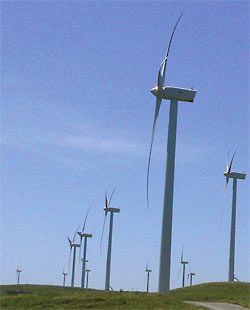An Answer Is Blowin’ in the Wind: Wind Power and Migratory Birds
By Andrew Farnsworth
October 15, 2009

Workshop sets research agenda for wind power and migratory birds
Every year, billions of birds migrate across the hemispheres, their massive movements linked to prevailing weather patterns, especially prevailing winds. Some areas where the largest movements occur overlap with areas where wind-power development seems most attractive.
A 2006 study on the impacts of wind turbines on birds and bats, completed by the National Academy of Sciences, concluded that:
- We lack adequate scientific data to make informed decisions on where to safely locate wind facilities.
- We lack enough scientific evidence to accurately estimate the risks of wind turbines to individual birds and populations.
- Methods for obtaining data about the effects of wind power are not standardized, making them difficult to use in policy making.
- Technologies for monitoring and mitigating risk are poorly developed.
We have estimates of annual bird mortality related to communications towers, skyscrapers, windows, pesticides, and cats, but we do not have enough information to provide robust and reliable estimates of the annual toll at wind turbines. We know mortality can vary extensively and may be significant at certain sites, and even at certain turbines, but we need a much clearer picture of regional and local migration patterns in space and time before we can hope to estimate mortality and exposure risks. The task of studying regional and local migration patterns seems straightforward but is deceptively challenging. Much of this movement occurs under cover of darkness, and many factors influence migration patterns. Biology aside, there are also many technological and analytical hurdles.
In June 2009, the Cornell Lab of Ornithology co-sponsored a workshop with the American Bird Conservancy and The Johnson Foundation, assembling academic, industry, conservation, and government experts in migration biology and risk assessment at existing wind facilities. Our goal was to identify as comprehensively as possible the research that must be accomplished to improve our understanding of exposure risks from wind-energy development to migrant wildlife. Research priorities include:
- Developing models to forecast migration traffic near existing and potential wind turbines. • Documenting topographic, seasonal, and climatic variables associated with potential hazards to wildlife that could be used to adjust operations to minimize risk.
- Outlining approaches for integrating different methodologies and models for assessing risks and mitigating impacts.
- Specifying criteria for identifying sites where wind farms would be most harmful to wildlife.
One hope is to develop a wide-scale network of sensors for collecting data to allow researchers to assess which regions and sites may face hazards from wind-power development, predict local and regional conditions under which exposure to these potential hazards may be greatest, and provide data for use in mitigation of potential risks. Ultimately we hope to expand monitoring capabilities on a hemispheric scale, vastly increasing our understanding of migration timing and pathways for individual species. Our work is driven by the need to ensure that wind power, which we believe is fundamental to reduce impacts of the world’s energy needs and usage, is developed in the safest possible ways to protect migratory birds and bats.
Andrew Farnsworth is a postdoctoral researcher in the Lab’s Conservation Science program.
Originally published in the Autumn 2009 issue of BirdScope.


All About Birds is a free resource
Available for everyone,
funded by donors like you


